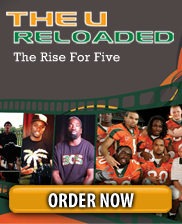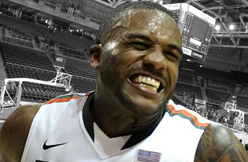INDIANAPOLIS -- The making from scratch of an NFL player begins at about 5:30 each morning at Erik Swoope's home near the Indianapolis Colts' training center. He prepares his own breakfast and then cues up his first tape session of the day -- usually not of himself and only occasionally of the Colts. Swoope is instead immersed in the work of tight ends around the league, paying special attention to the ones who played basketball. He watches Jimmy Graham and Antonio Gates and Julius Thomas for the little moves they make to get open that hark back to their crossovers, or for footwork that is in various stages of evolution from the improvisational nature of the hardwood to the more structured steps on the gridiron.
Swoope recognizes the basketball in those players, even as it is slowly being coached out of them -- the way it is just beginning to be coached out of him, too.
Hanging in Swoope's locker -- he is in a pod of the extra lockers set in the middle of the Colts' locker room, with the other undrafted rookies -- is a University of Miami backpack, a relic from a different time and a different sport. Swoope was a four-year basketball player at Miami, a 6-foot-5 power forward known for his athleticism and for having the intelligence to understand every position on the floor. He was 6-2 by the time he was in sixth grade and already jumping above the rim. The AAU teams began to circle, and then, a few years later, the talk about college scholarships began. The risk that injury would derail those possibilities was too great for him to seriously entertain the playful chatter he and his friends engaged in about playing football.
And so he never did -- not when he was already too big for Pop Warner, not when he was taking the court for Harvard-Westlake High School in Los Angeles, the elite hoops program that produced Jason and Jarron Collins, and not at Miami, where Swoope earned a degree in economics while laying the groundwork for a playing career.
Just not the one he has now.
Swoope went to coach Jim Larrañaga's office on March 14, the day after the Hurricanes' season ended with a loss to North Carolina State in the ACC Tournament, expecting to discuss his hopes of playing basketball overseas. It was to be a routine end-of-season meeting. Instead, Larrañaga surprised him with some news: The coach had received a call from the Denver Broncos, whose area scout, Nick Schiralli, had heard from his college connections about Swoope's athletic gifts.
"I was completely shocked," Swoope said of his conversation with Larrañaga. "When my coach presented the opportunity, I was almost in disbelief. They told me they were looking for guys 6-4, 6-5 who could catch the ball and run fast. It was almost a spit-balling idea."
Perhaps. But it is grounded in precedent. After the success of players like Gates with the San Diego Chargers and Thomas with the Broncos -- and of course, most famously, Tony Gonzalez with the Kansas City Chiefs and Atlanta Falcons -- teams are on the lookout for basketball players of similar height, weight and speed, believing they have at least as much potential as some prospects who have played football all their lives.
Colts general manager Ryan Grigson said that when there is a basketball player who has the physical attributes that could enable a transfer to tight end and who "can walk and chew gum at the same time," he wants to at least ask if that person is interested in football.
Swoope was, but he did not accept the invitation to work out with Denver immediately. First, he sought the counsel of, among others, Graham, the former Hurricanes basketball and football player whom Swoope had met as a freshman, when Graham was just joining the New Orleans Saints. Miami's trainer had always compared the two of them, and had told Swoope that he thought his nature -- his speed and strength and quickness, his ability to play every position, from shooting guard to center, while still knowing what the point guard did -- would make the transition smoother, as it had for Graham.
"The main thing Jimmy did was ask me character questions -- What motivates you?" Swoope said. "He said, 'If you're going to make this change, don't let it just be on a whim. If it motivates you, strive for it.' We didn't talk about X's and O's, just about character."
There is, of course, one critical difference between Swoope and Graham, Gates and Thomas. Like Graham, Thomas, a Portland State product, had played some college football. Gates was a top tight end at the high school level before opting for basketball at Kent State. Swoope had none of that background -- he had never played organized football of any kind, had never put on shoulder pads -- and he had just seven days to get ready for the workout with the Broncos. He worked mostly on catching drills, getting some pointers from his brother, Devin, who had played basketball before switching to football, eventually landing at Northwood, a Division II program. Devin, in fact, made the even more unfathomable transition from nose tackle (at 315 pounds) to receiver, which necessitated a 100-pound weight loss.
Swoope watched NFL Network. He found clips of the NFL Scouting Combine on YouTube, so he would know what drills to expect in his workout. He even studied the Madden video game, to gain some rudimentary knowledge of routes.
The audition with the Broncos did not net Swoope a spot with the team, but others were curious about his potential. The Colts had heard through the scouting grapevine that Swoope was interested playing football, so director of college scouting T.J. McCreight approached Grigson about his interest level.
Indianapolis has taken on a number of projects over the years -- including Daniel Adongo, a Kenyan-born rugby player now entering his second season in the NFL. But Grigson had to be sold on the idea of Swoope.
Then the GM began to think the stars might align. On the Colts' staff are coaches Rob Chudzinski and Alfredo Roberts, both former Miami tight ends. The national scout who worked Swoope out, Matt Terpening, played college basketball, too. And then there's the fact that former Colts tight end Marcus Pollard spent 10 seasons with the team despite having played only basketball in college.
"Then I Googled (Swoope) and saw a dunk against Virginia Tech," Grigson said, of a rim-rattling one-handed slam delivered during the ACC Tournament. "A lot of guys would be envious of how he throws it down; he was aggressive to the hole. The way he got here -- is it crazy? At first, it can seem that way. But when you look at who the best tight ends have been -- Tony Gonzalez, Antonio Gates, Jimmy Graham -- it makes sense."
In the less than three months that he has been playing football, plenty has not made sense to Swoope. Like when he first got the Colts' playbook after signing as an undrafted free agent.
"I looked at it, and it was, 'This is Chinese. I have no idea what I'm looking at.' " Swoope said.
Since then, he has become so immersed in football that he has not even spoken to his family about basketball. Swoope's weight training program from Miami has transitioned well to the NFL, as he already has put on about 20 pounds from his senior-year playing weight -- he is at 246 pounds now -- and likely has another 10 to go. Football's necessary emphasis on developing size and strength is a departure from the emphasis on joints demanded by spending so much time in the air during basketball games.
"Basically, everything has to get bigger," he said.
The greatest adjustment, though, has been mental, as he moves from the more improvisational style of basketball to the more rigorously structured execution of football. Thomas, who says he still feels like he is early in his own adjustment to football, declared that one of the things that surprised him about football was the length of the day and the level of detail covered at meetings.
"In basketball, you practice and go home. I couldn't imagine if a basketball coach went through and said, 'Look how high your step was,' " Thomas said. "In football, it is so strict on what you're doing and how you're doing it."
And so Swoope is learning nuances that many of his teammates might have first encountered as early as childhood -- not just the play and the formation and the reads, but knowing what everybody else on the field is doing and how his tempo will affect others. It is the difference between knowing that in basketball everyone can get open and recognizing that in football he might be running his route to allow others to work free. Veterans have given him tips on everything from how to block for a run to keeping his eyes on specific defenders.
Working against defenders in OTAs has helped Swoope understand the value of foot fakes and hand positioning, and what a difference doing it correctly makes. And when he watches the film of the former basketball players, he notices how much more structured their physical positioning -- where their feet and hands are -- gets as they spend more time in the NFL.
"I've been surprised at how specific it is, and then when you do it, I'm surprised at the difference it makes," Swoope said. "In basketball, everybody has a different shot form, or a different way they lay it in. In football, there has been, through history, proven ways that work. You emulate those very specifically."
With Dwayne Allen and Coby Fleener, two promising youngsters selected in the 2012 NFL Draft, the Colts are loaded at tight end. So Swoope is a likely candidate for the practice squad or to make the active roster as a special teamer, a job that would probably suit him because of his basketball-bred ability to play in traffic.
Grigson admits that when Swoope arrived with the other rookies after just a few weeks of running routes, he expected coach Chuck Pagano to give him an eye roll when he first saw the new project. Instead, both men were encouraged when they noticed that Swoope already knows how to get out of breaks.
"We didn't know if he would look like a fish out of water," Grigson said. "But his burst, his body control, the way he caught the football were all really, really good signs. You saw raw athletic ability. He's very mature, very businesslike. He was already a pro and he never played. He's wise beyond his years."
Grigson went on to praise Swoope's fortitude, recalling a minor injury that the prospect brushed aside earlier in offseason workouts: "Here's a basketball guy, but he's got a little hamstring and he doesn't want an MRI. He wants to get out there. There's something there."
Whatever it might turn out to be, Swoope is still spectacularly raw less than three months into his immersion program, learning a game -- as Thomas explained it -- at a level that equates to learning addition and subtraction while everyone else on the field is doing calculus. Swoope is still, Grigson said, a very rare case, because he has to learn everything for the first time.
Thomas' coach, who also worked with Gates in San Diego, offers a dose of reality.
"It's much more difficult than it looks," Broncos tight ends coach Clancy Barone said. "For every one player that was a college basketball player that does make it, there are another 25 who don't. Mentally, they can't figure it out, or physically, the demands are too much."
Those are the odds that Swoope is confronting now, and they're certainly much longer than his odds of playing basketball in Europe would have been. The start of his first football season is still more than a month away, but in Indiana, where basketball dominated for generations until Peyton Manning moved to town, it has been hard for Swoope to escape the end of the season for the sport -- with its comfortable familiarity and dreams -- he has left behind.
"In my head, this is where I want to be," he said. "We've been talking about the playoffs a lot. But I wanted to make this sacrifice, and I'm not second-guessing myself."

(nfl.com)



